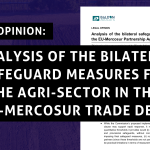Written by Yelter Bollen, Policy expert Climate & Financing at Bond Beter Leefmilieu and Greg Van Elsen, Policy Lead on Clean Industrial Deal at CAN Europe
The European Commission’s Competitiveness Compass promises to snip off 25% of today’s regulatory burden, arguing that ‘regulitis’ is stifling Europe’s economy — sustainability reporting, in particular, being considered a dead weight. But is regulation truly the problem, or just an easy scapegoat?
The new corporate reporting requirements oblige businesses to map out their sustainability risks. While this requires a substantial mind shift, calling it a major competitive handicap is exaggerated. According to EFRAG, a corporate reporting industry body, compliance with the Corporate Sustainability Reporting Directive (CSRD) costs large companies just 0.026% of their revenue. A study commissioned by Vlaio, the Flemish innovation agency, finds only limited additional costs for SMEs. The idea that sustainability reporting is crushing European industry simply isn’t supported by the numbers.
Moreover, many sustainable SMEs stand to benefit from these rules, as the playing field has long been skewed in favour of their less sustainable competitors. The real costs come when companies take actual steps to make their operations more sustainable—but that is a separate issue from regulation itself.
Transparency about sustainability risks isn’t just a bureaucratic exercise, it’s essential both for companies and for society. Businesses need to understand and mitigate their risks, while investors, policymakers, and consumers need accurate environmental data to make informed decisions.
Unleash the beast
The main barriers to investment, according to the European Investment Bank (EIB), are energy costs, labor shortages, and economic uncertainty—not regulation. Only 20% of companies identify regulation as a major obstacle, while 40% report only minor difficulties. Meanwhile, a significant number of companies see climate regulation as an opportunity rather than a threat.
Interestingly, businesses in the U.S. complain even more about over-regulation than their European counterparts. This challenges the narrative that Europe’s regulatory burden is uniquely stifling innovation.
The European Commission estimates that cutting regulations would save businesses €38 billion per year—a seemingly large figure, but in reality it amounts to just 0.2% of EU GDP. While efficiency improvements are always welcome, this level of cost reduction is unlikely to have a transformative impact on European competitiveness.
Moreover, many of the regulations under attack are there for a good reason. They deal with the safety of our children’s toys, systemic risks in the financial sector, what ends up in our lungs and drinking water, and protect consumers from misleading claims. These rules have been developed through extensive discussions that included business concerns. To repackage them as harmful ‘red tape’ ignores the broader public interest.
A weak stance?
This is not to say that all regulations are perfect. There is certainly room for simplification, better enforcement, and the replacement of redundant national procedures with streamlined EU-wide rules. However, setting an arbitrary target such as ‘25% less regulation’ is an overly simplistic approach to a complex issue.
More importantly, it does not address the real structural challenges facing European industry – high energy costs, supply chain disruptions, and a shortage of skilled workers. The Competitiveness Compass does contain some useful ideas about energy markets, financing, and circularity to tackle the planetary crisis, but real solutions require political will and long-term commitment—something that is still largely lacking in many European capitals.
Instead of focusing on an easy but misleading anti-regulation narrative, the EU should focus on ambitious reforms that truly boost competitiveness. Real leadership means tackling the tough issues, not just cutting regulation for the sake of it.



